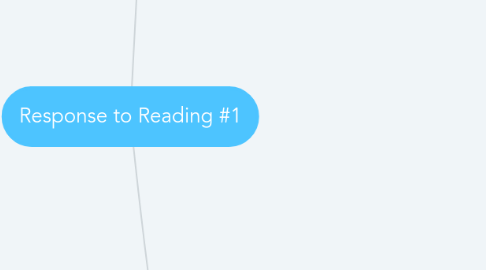
1. Chapter 11: Reading Literature
1.1. Experiencing Literature
1.1.1. Aesthetic Reading: reader is carried away by feelings evoked
1.1.2. Efferent Reading: reader "carries away" meaning
1.1.3. Close Reading--process: -select text, read to get gist, read to understand further, read to analyze
1.1.3.1. reader response: emotional involvement to text
1.1.4. Envisionment: the understanding that a person has at a given point in time
1.1.5. Annotations
1.1.5.1. start with: -underlining key details, highlighting confusing phrases, writing comments, questions, responses, etc. (in margins)
1.1.6. Using Journals
1.1.6.1. response journals--responding to the literature
1.1.6.2. literacy journals: student assumes role of character and writes through him/her
1.1.6.3. double-entry: on left, student records something from text. on right, student reflects
1.1.6.4. dialogue journals: student writes to teacher, teacher responds
1.2. Using Discussion to Develop Analysis and Response
1.2.1. Quality Talk
1.2.1.1. via literature discussion groups (literature circles, book clubs, study groups)
1.2.2. Literature Discussion Groups as Cooperative Learning
1.2.2.1. GROUPS: discussion leader, summarizer, lit. reporter, illustrator, word chief, and connector
1.2.2.2. each student has a role/job in their literature group
1.3. Types of Literature
1.3.1. Folklore
1.3.1.1. Folk Tales: students investigate cultures
1.3.1.2. Fables: tell a story and teach a lesson
1.3.2. Poetry
1.3.2.1. by popular demand: humor, narratives, and rhyming
1.3.3. Chapter Books and Novels
1.3.3.1. separate unit of study (more complex)
1.3.3.2. Analysis: characters, plot, and theme
1.3.3.3. Mood: what the reader feels Tone: author's attitude--what the reader thinks
1.3.3.4. Point of View: -first (I) -second (you) -third (narrator)--omniscient or limited
1.3.4. Drama
1.3.4.1. Plays
1.3.4.2. Dramatizations
1.3.4.2.1. characters must "come alive" during reading
1.3.4.3. Story Theater
1.3.4.4. Reader's Theater
1.3.4.4.1. students dramatize selection by reading aloud
1.3.5. Literary Nonfiction
1.3.5.1. biographies
2. Chapter 12: Approaches to Teaching Reading
2.1. Basal/Anthology Approach
2.1.1. begins with emergent and works its way up to 5th/6th grade
2.1.2. four different kinds still used today
2.1.3. materials available for average, above-average, and below-average readers
2.1.4. Advantages
2.1.4.1. many resources, steady progression, and varied reading selections
2.1.5. Disadvantages
2.1.5.1. materials won't generate enough interest for every student
2.1.5.2. pacing
2.1.5.3. leveled selections
2.1.5.3.1. not challenging enough for some
2.1.5.3.2. too challenging for some
2.1.6. Solutions to Dilemma
2.1.6.1. have each student work in their level area
2.1.6.2. take advantage of intervention programs
2.1.7. Adapting Basals
2.1.7.1. build interests of students
2.1.7.2. use available workbooks and practice materials
2.1.7.3. expand variety of reading materials available
2.1.7.4. specify and utilize skills and strategies in an appropriate manner
2.1.7.5. important!--struggling readers should read every single day
2.2. Literature-Based Approach
2.2.1. Core Literature
2.2.1.1. selected by teachers for careful reading
2.2.1.2. advantages: builds class community and provides a rich literature foundation
2.2.1.3. disadvantages: -students have different interests -text can be easily over analyzed (issue of moving too fast or not moving fast enough)
2.2.2. Text Sets
2.2.2.1. groups of related books
2.2.2.1.1. same genre, topic, question, etc.
2.2.2.2. allows opportunities for making connections
2.2.2.2.1. deepens reader's background knowledge
2.2.3. Thematic Units
2.2.3.1. built around diverse topics, subject(s), texts, and goals or standards
2.2.3.2. Implementing Thematic Units
2.2.3.2.1. select theme, involve students in plan, state goals for understanding, decide on reading materials (plus resources and activities), plan unit opener, and pre-assess students beforehand
2.2.4. Self-Selection
2.2.4.1. students select what they want to read--generates more interest and effort in understanding the material
2.2.5. Advantages and Disadvantges
2.2.5.1. advantages: books are chosen to meets students needs and interests
2.2.5.2. disadvantages: literature could be misused and books chosen may not interest all students or are too difficult
2.2.6. Adapting the Approach
2.2.6.1. use for whole class, small groups, and individually
2.3. Individualized Reading/Reading Workshop
2.3.1. Preparation Time
2.3.1.1. mini-lesson
2.3.1.1.1. -explain why topic was chosen -teacher explains/models skill -students become actively involved -connect strategy to story -how did students apply strategy?
2.3.1.2. book talk
2.3.2. Self-Selected Reading and Responding
2.3.2.1. conferences: both small group and individual
2.3.2.2. dialogue journals-students respond to assigned readings, then teacher responds to student's response
2.3.3. Student Sharing
2.3.3.1. students share reading or parts of reading with the class (different methods may be utilized)
2.3.4. Organization
2.3.4.1. there should be seven times as many books to students
2.3.4.2. students are responsible for keeping track of which books they check out
2.3.4.3. NO interruptions during conferences (important)
2.3.5. Advantages and Disadvantages
2.3.5.1. advantages: self-selection, move at own pace, using group processes, and relating reading and writing
2.3.5.2. disadvantages: potential neglect of certain skills, and teacher spread too thin with journals/conferneces
2.3.6. Adapting the Program
2.3.6.1. can be used with basal readings
2.3.6.1.1. example: use basal for three days and individualized reading/reading workshop for the other two (and vice versa)
2.3.6.2. teaching students how to select books
2.3.6.3. holding conferences are KEY
2.4. Other Approaches
2.4.1. Leveled Readers
2.4.1.1. can be used with or as supplements to basal readers
2.4.1.2. advantages: flexible, available, effective reading stepping stones
2.4.1.3. disadvantages: not the most effective in reinforcing decoding skills
2.4.2. Language Experience Approach
2.4.2.1. in groups: teacher acts as scribe for whole group--changes are made in wording
2.4.2.2. individually" teacher acts as scribe and writes what student says (verbatim)
2.4.2.3. advantages: builds on language experience
2.4.2.4. disadvantages: reading is limited to only the student's experiences
2.4.3. Guided Reading
2.4.3.1. reading instruction uses grouping according to student's level of development
2.4.3.2. requires obtainment of appropriate texts, proper group placement, teacher monitoring, and development of certain processing skills
2.4.3.3. advantages: instructed on their reading levels and offers adequate support
2.4.4. Digital Programs
2.4.4.1. reading programs available online
2.4.4.2. blended learning
2.4.4.2.1. combination of teacher-led instruction and digital technology
2.4.4.3. adaptive programs
2.4.4.3.1. Achieve 3000
2.4.4.3.2. IStation
2.4.4.3.3. Lexia Learning
2.4.5. Project Approach
2.4.5.1. Project Based Learning
2.4.5.1.1. work alone or in groups to complete a project
2.4.6. An Integrated Approach
2.4.6.1. combination of approaches for more effectiveness

